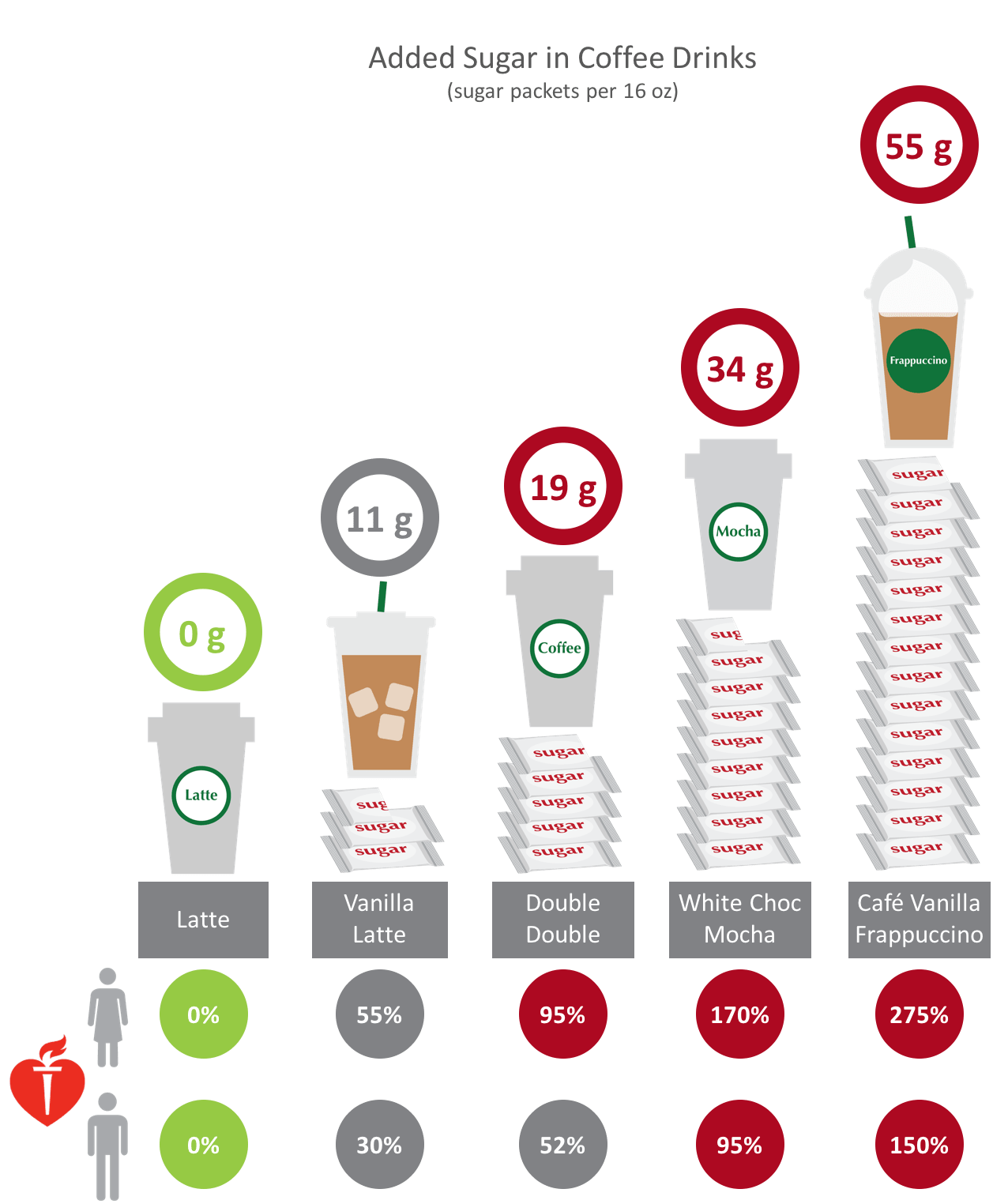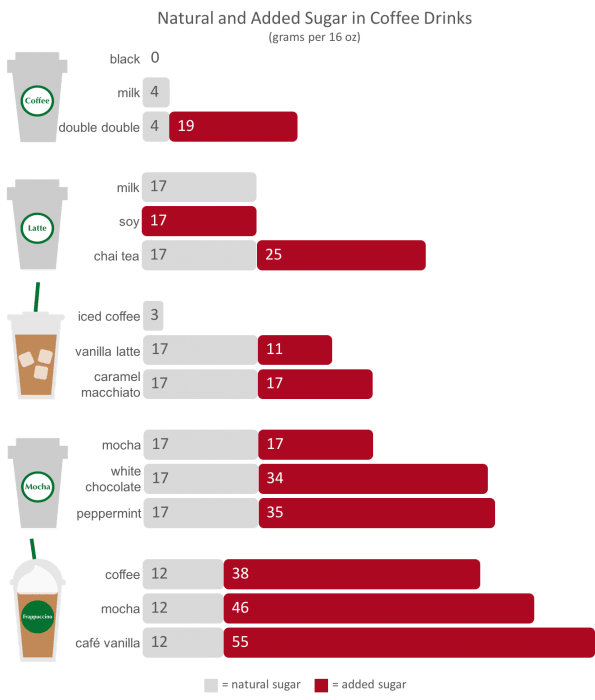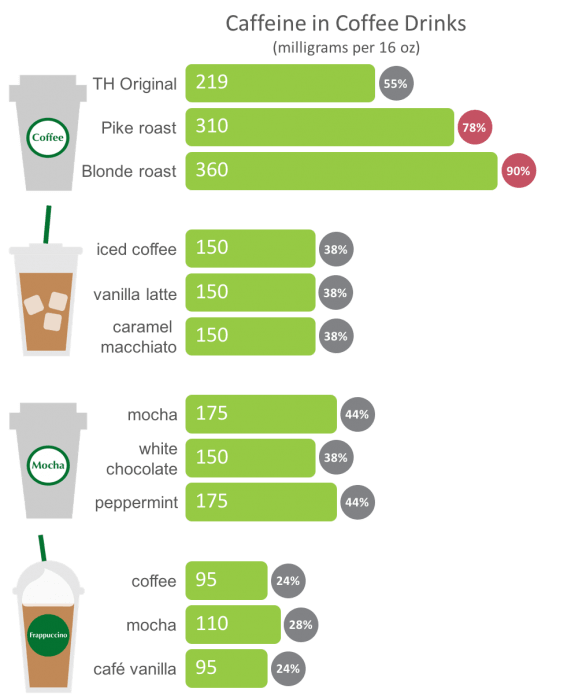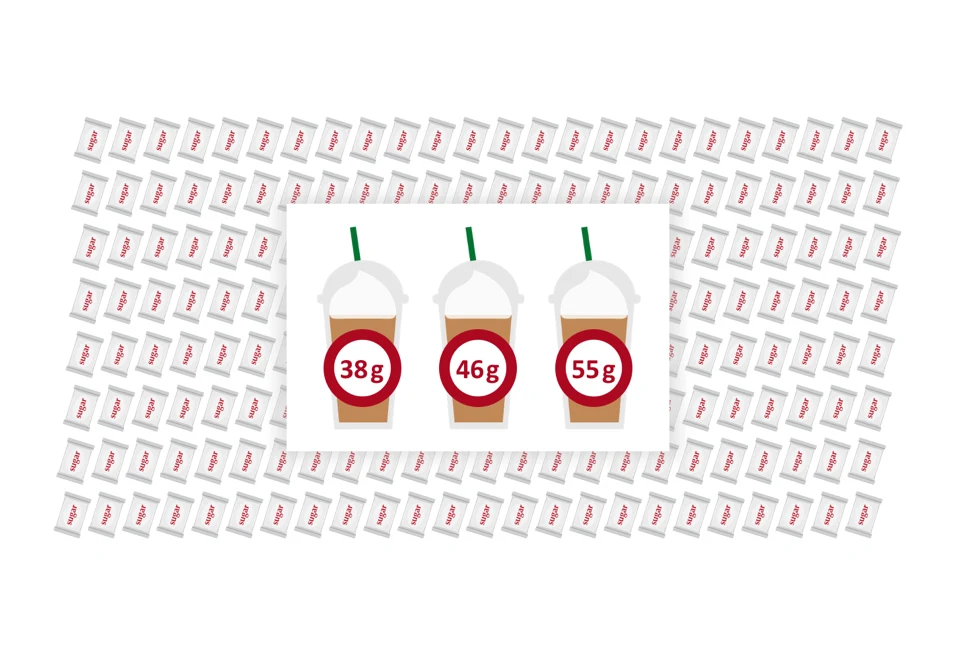There are so many options choosing a coffee based drink. In addition to normal drip coffee, you can also get an espresso drink, a blended coffee, or a variety of tea drinks.
But have you ever looked at the nutrition information for coffee drinks? Depending on where you live, some coffee shops will list the calories in a beverage on the menu, but that doesn’t tell you the ingredients or break out the amount of added sugar in a drink.
If you have been reading my articles for a while now, you know that the ingredients in our foods matter as does the amount of added sugar we consume.
How healthy is your favorite coffee drink?
For simplicity, and due to my Pacific Northwest roots, I chose to evaluate the most popular Starbucks drinks.(2) And for our readers in Canada, I threw in Tim Horton’s Double Double.(3)
When evaluating if your favorite coffee drink is healthy, there are three main areas to consider:
- Amount of added sugar
- Caffeine content
- Additional ingredients you wouldn’t normally expect in a coffee
Most coffee drinks contain high levels of added sugar
The graphic below shows the added sugar in popular Starbucks coffee drinks. The grams of sugar are listed for a single 16-oz coffee drink.
Frappuccino drinks contain the equivalent of 9.5 to 13.75 packets (teaspoons) of sugar and almost two to three times the American Heart Association’s daily recommended intake of added sugar for an adult woman.(4)
These drinks are more caffeinated milkshakes. If you add whipped cream to it the Cafe Vanilla Frappuccino®, it has essentially the same nutritional profile as a McDonalds McCafe® Vanilla Milkshake.(5)

At the bottom of the graphic is the percentage one drink contributes to the AHA’s daily recommended intake of added sugar for men and women.
How the amount of added sugar was calculated for Starbucks Coffee Drinks
Specifying added sugar on the Nutrition Facts of a product is still optional. So figuring out the amount of added sugar in a dairy-containing food can be challenging as these foods also include lactose from milk.
To calculate the amount of added sugar in a coffee drink, we made teh following assumptions.
- 16-oz beverage
- made with 2% milk
- no optional whipped cream
The quantity of milk used in the calculation is as follows: Latte (12-oz), Mocha (12-oz), Frappuccino® (8-oz), brewed coffee (3-oz).
It is worth noting that there are 4 grams of added sugar in a teaspoon of sugar or sugar packet.
Below is a table highlighting the natural (lactose) and added sugar in various coffee drinks.
As is probably expected, black brewed coffee or coffee containing only milk has no added sugar.
A plain latte also contains no added sugar, though the amount of milk is understandably higher than a brewed coffee with milk. Lattes and mochas differed only in the types of additions they contained (flavor syrups and / or chocolate syrup).
Frappuccinos® are the surprising result here containing less milk than a traditional espresso drink but substantially more added sugar.

Caffeine Content in Coffee
The 2015-2020 Dietary Guidelines for Americans states that “moderate coffee consumption (three to five 8-oz cups/day or providing up to 400 mg/day of caffeine) can be incorporated into healthy eating patterns.”(6)
There is consistent scientific evidence showing that coffee consumption by healthy adults is not associated with an increased risk of chronic diseases.(6)
However, higher levels of caffeine consumption can lead to insulin resistance and have other negative health effects.(7)
As with most things, moderation is the key. Enjoy your coffee, but don’t make it and other caffeinated beverages your only drinks throughout the day, and have an idea of how much caffeine you are routinely consuming.
Below is a table of the approximate levels of caffeine in some popular coffee drinks.(1,3)

Other Ingredients in Coffee Drinks
Coffee drinks contain coffee, milk and maybe sugar, right? Well, it depends on what you drink. Any coffee drink with an added flavored syrup or sauce will contain a whole string of ingredients. Below are some examples:(1)
- Vanilla Syrup: Sugar, Water, Natural Flavors, Potassium Sorbate, Citric Acid
- Caramel Sauce: Sugar, Corn Syrup, Butter, Water, Heavy Cream, Nonfat Dry Milk, Natural Flavors, Salt, Mono & Diglycerides, Soy Lecithin, Sulfites
- Coffee Frappuccino® Syrup: Sugar, Water, Salt, Natural and Artificial Flavors, Xanthan Gum, Potassium Sorbate, Citric Acid
These syrups and sauces are the source of most added sugars in flavored coffee drinks. They also all contain preservatives (potassium sorbate, sulfites) and artificial flavors, both of which can cause allergic reactions in a small subset of the population.(8)
Final Thoughts on Coffee Drinks
Instead of ordering a pre-sweetened coffee, consider ordering a plain coffee and adding your own sugar. One or even two packets of sugar can be added to coffee while still maintaining a healthy lifestyle.
Finally, Frappuccinos® are not coffee. They are caffeine containing milkshakes that contain two to three times the AHA’s recommended daily intake of added sugar for an adult woman. Avoid them or consider them as the truly occasional treat that they are. We are routinely eating and drinking too much added sugar, and it is negatively affecting our health.
References:
- Starbucks Nutrition Information, Starbucks Website (link)
- What people order at Starbucks around the US, Quartz Media Website, (link)
- Tim Hortons Nutrition Information, Tim Hortons Website (link)
- Dietary Sugars Intake and Cardiovascular Health. Rachel K. Johnson, Lawrence J. Appel, Michael Brands, Barbara V. Howard,Michael Lefevre, Robert H. Lustig, Frank Sacks, Lyn M. Steffen and Judith Wylie-Rosett. Circulation. 2009;120:1011-1020, originally published September 14, 2009 (link)
- Nutrition summary for McDonald’s McCafe® Vanilla Shake, McDonalds Website (link)
- Dietary Guidelines for Americans, 2015-2020, Eighth Ed. (link)
- Always Hungry? Conquer Cravings, Retrain Your Fat Cells & Lose Weight Permanently, David Ludwig, MD, PhD, 2016 (link)
- Center for Science in the Public Interest. Chemical Cuisine. (link)

Meredith
Thursday 20th of April 2017
Update: For anyone wondering, the Unicorn Frappuccino contains the same amount of added sugar as a Vanilla Bean Creame Frappuccino: approximately 43 grams for a 16-oz serving (this assumes 12 grams of the "sugar" listed on the nutrition facts is from 8-oz of 2% milk).